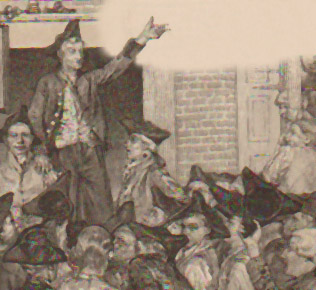
Chapter 1
JOHN RHODE
(1752-1840)
First Generation of the Rhode Family in America
JOHN RHODE IMMIGRATES TO AMERICA
According to family tradition, John Rhode came to America from Germany. Of where he lived in Germany, his parents, or his early occupation, nothing is known. The year he came to America is not known, but it has been said he arrived just before or some time during the Revolutionary War, which was waged in America during the years 1776 to 1782. If John Rhode arrived at the beginning of the Revolution, he would have been 24 years of age. His occupation in America was farming. He was a Quaker. Some of his children followed this belief.

SERVICE IN THE REVOLUTIONARY WAR
There has always been a good deal of speculation in later years among the descendants of John Rhode as to his service in the Revolution.
The case for his service:
1. Family tradition that John Rhode came to America as a young man and enlisted in the Revolutionary War.
2. One of his great-granddaughters Harriet (Rhode) McCormick (Joseph Jonathan John) always insisted that she had learned from older members of the family that John Rhode took part in the Revolutionary War as a baggageman or teamster. As he was a Quaker, his belief would not favor the bearing of arms (which was not always followed when settlers had to defend their homes), but he would be free to act as baggageman or teamster to aid the cause.
3. Rev. Peter Jacobs, Minister of the Congregational Church of Tabor, lowa, in his "Reminisces" published in the Tabor Beacon January 1934, stated: "John Rhode served under General Marion in the Commissary Department during the Revolution."
4. Fern Williams (Elsie Allice Jonathan John) of Tabor, Iowa, made the same statement in 1947 as Rev. Jacobs, adding that John Rhode was discharged in South Carolina.
5. It is well known that on Decoration Day, John Rhode's grave in the old Quaker Cemetery near Attica, Ind, was decorated as one of the Revolutionary soldiers.
The case against his service:
1. Mr. A. S. Sally, State Historian Commission of South Carolina, in a letter to Ellis Rhode, May 26, 1946, makes the following statement: "We have no record of a Revolutionary soldier of this State of South Carolina named John Rhode." (However this does not preclude him from serving in another state.)
2. He is not listed in the official records as a Revolutionary soldier.
Conclusion:
Family tradition from many sources as given insists that John Rhode served in the Revolution. While family tradition is very important and has to be taken into account, it cannot always be relied upon. There seems to be no official government confirmation of his service in any state. However, there were many residents who took part in local skirmishes who were never regularly enrolled as soldiers. It is entirely possible that John Rhode took part in the war with General Marion, who was known as the "Swamp Fox" and who directed guerrilla warfare in the vicinity of Charleston, South Carolina, near where John Rhode afterward settled on a plantation.
There is one other piece of information. (However, there were other John Rhodes listed in the 1790 census of South Carolina) In the stub entries by A. S. Sally showing payment of Revolutionary claims against South Carolina P188 is the following entry:
"#479 Book P Issued this 9th of May 1785 to Mr. John Rhodes for three pounds 489—Sterling—for provisions for the State Troops & Militia in 1780-81 as part of the account audited. Principal S 4.9—Annual interest S 4.6"
JOHN RHODE MARRIES MARY LEWIS
John Rhode according to family records married Mary Lewis, who was born July 22, 1764. So she was twelve years younger than he was. They were probably married in South Carolina after the close of the Revolution. It is said they were married in a little stone church on a small island in the harbor of Charleston. Their first child William, was born in 1785. Available marriage records (Clemons, North & South Carolina Marriage Records), which are not complete, do not list this marriage. Nothing is known of the parents of Mary Lewis. A sister of Mary Lewis, whose name was Hester Lewis, is said to have married a Seymour Cobb, which was the first Rhode and Cobb union.
SOUTH CAROLINA CENSUS OF 1790 LISTS JOHN RHODE AS FOLLOWS:
Heads of Families
First Census of the United States 1790
State of South Carolina
Charleston District, Dorchester County, St. George Parish
Name of family
John Rhode
White males of sixteen years and upward including head of family
1
Sons under sixteen years
3
White females including wife
1
Slaves
2
Above is John Rhode, our ancestor. He had three sons at this time: William, born 1785, Jonathan 1788, and Caleb 1790. His other two sons and two daughters were born later. Also this was the location of his plantation as will be described later.
Now of course the spelling of Rhode is wrong. However, many of the census takers were unlettered, and thousands of mistakes were reported in this census.
One other interesting thing about the census of this St. George Parish or Township is that there are three other "Roads" listed as heads of families, namely Henry Road, William Road and Christian Road. Could these be brothers or relatives of John Rhode? In those early times it was a common thing for relatives to settle in the same neighborhood. Annie Dash Moorer of Walterboro, South Carolina, thought it very possible that they may have been brothers of John Rhode. However, family tradition so far as known has never mentioned any brothers of John Rhode.
OLD LAND GRANT OF JOHN RHODE PLANTATION
In 1948 Annie Dash Moorer sent the author an old, yellowed Land Grant (rescued from an attic) for the purchase of John Rhode's South Carolina plantation. This grant, dated 1796, is mostly handwritten. On one side is a plat showing as boundaries the Edisto River and various trees. A part is missing. It is made out to John Rode (note the spelling). No price is mentioned. The final words read: "Witness his Excellence Arnoldus Vanderhorst Esquire, Governor and Commander in Chief in and over said State, at Charleston this Fourth Day of January Anno Domini One Thousand Seven Hundred and Ninety Six and in the Twentieth Year of the Independence of the United States of America."
This old grant gives confirmation of the family tradition that he had a plantation in South Carolina. It establishes the location on the Edisto River in Dorchester County, St. John's Parish near the town of St. George, about fifty miles from the port of Charleston. The size of the plantation was 500 acres.
It was very fortunate indeed that this historic document was found and made available to posterity.
[ANN MILLER CARR'S EXCITING NEW RESEARCH]
In 2002, Ann wrote the following: I found documents in South Carolina that give clues on the Lewises, Eleanor Lewis Easterling, and Esther Rhode Summer's family. William Lewis, father of our Mary Lewis Rhode and Esther Lewis Cobb, died when Esther was just a baby, around March of 1884. His father was Thomas Lewis, and William had a brother named Thomas. William's brother Thomas's descendants came north to Ohio with the Rhodes and Cobbs; some came to Warren County, Indiana, later, but ended up in Vermilion County, Illinois. Semer and Esther Lewis Cobb lived there with them in the late 1820s. In early 2010, Kenny Hughes of Bamburg, South Carolina, a Hughs/Hughes family genealogist, sent us his research, which offers strong evidence supporting the conclusion that Mary LNU Lewis Easterling was Mary Hughs/Hughes Lewis Easterling. Caleb Hughs/Hughes, whose property was adjacent to John and Mary Lewis Rhode's in St. George Parish, Colleton (Now Dorchester) Co., South Carolina, was most likely Mary Hughes? Lewis Easterling's brother; their father may have been named Jonathan Hughs/Hughes, a Quaker who had membership in the Merion MM in Chester (now Montgomery) Co., Pennsylvania. Jonathan Hughes was the son of David and Martha Lewis Hughes, who married at the Merion MM on 4 Nov. 1696. Martha Lewis was the daughter of Ralph and Mary Lewis. It is unknown if Ralph and Mary Lewis are related to Thomas Lewis, the father of William Lewis. William Lewis was the first husband of Mary Hughes? Lewis Easterling, and the father of her children, including Mary Lewis Rhode, Esther Lewis Cobb, and Eleanor Lewis Easterling. Jonathan Hughes, born in 1703, had a brother named Caleb Hughes, and Jonathan and this Caleb later migrated to Dobbs Co. and Lenoir Co., North Carolina. There are deeds in that county for Jonathan and Caleb. (Dobbs was later divided between Lenoir and Glasgow [now Greene] Counties and ceased to exist. In 1777, Jonathan Hughes reportedly of South Carolina sold his lands in Lenoir and Dobbs Counties. Mary Hughes? Lewis, widow of William and mother to our Mary Lewis Rhode and Esther Lewis Cobb, remarried about 1780 to John Daniel Easterling. We have a copy of a document found in the South Carolina State Archives wherein John releases his rights to William Lewis's property, which his wife Mary Hughes? Lewis Easterling inherited. The document states that William Lewis' Land will be inherited by William's children. This document may have been drawn up after the birth of Caleb Easterling, who is believed to be the only child of John Daniel and Mary Hughes? Lewis Easterling. Mary Hughes? Lewis Easterling died after 1780, perhaps around 1788. Eleanor Lewis Easterling's husband was named Henry. His relationship to John is unknown, but he probably was related. For example, Henry could be John's child from an earlier marriage. Then again, Henry could be a younger brother to John. Henry Easterling was John Daniel Easterling's son by his first marriage to Elizabeth Moore. According to Henry Easterling's 1800 census record in Colleton Co., South Carolina, Eleanor Easterling Melton definitely had two sisters and also possibly two brothers. Her sister Mary Easterling, like Eleanor a ward of their uncle and aunt John and Mary Lewis Rhode, married John Townshend on 2 Jul. 1807 in Warren Co., Ohio. Mary Easterling had not yet reached her maturity (age 18) as Mary Lewis Rhode gave her permission for the marriage. Her other sister, Ann Easterling, married Isaac Wilson at the Caesar's Creek MM in Warren County, Ohio. A descendant of Ann Easterling Wilson says their family line states that Ann and Eleanor were sisters, and Quaker records from Caesar's Creek MM confirm this. Unlike her sisters Mary and Eleanor, she was reared by another family: Caleb and Martha Jane Murray Easterling. Martha Jane Murray was the elder sister of William Murray IV (who married Mary Rhode) and Sarah Murray, who married William Rhode. As Caleb Easterling is almost certain the half-brother of Mary Hughes? Lewis Easterling, and William Rhode and Mary Rhode were children of Mary Hughes? Easterling's daughter Mary Lewis Rhode, Sarah Jane Murray Easterling became an aunt by marriage to her own brother and sister! Here is information on Ann Easterling Wilson's family:
Descendants of Ann Easterling
Generation No. 1
1. ANN2 EASTERLING (HENRY1) was born Abt. 1800 in South Carolina. She married ISAAC WILSON October 05, 1820 in Caesar's Creek Twp., Greene Co., Ohio. He was born July 26, 1799.
Children of ANN EASTERLING and ISAAC WILSON are:
i. ENOS3 WILSON, b. December 02, 1821; m. REBECCA UNKNOWN, Abt. 1843, Ohio.
More About ENOS WILSON:
Residence: 1850, Warren Co., Ohio
ii. AMOS WILSON, b. February 17, 1826.
iii. MARTHA WILSON, b. July 29, 1828.
Descendants of Henry Easterling
Generation No. 1
1. HENRY1 EASTERLING He married ELEANOR LEWIS, daughter of WILLIAM LEWIS and MARY HUGHES?. She was born July 21, 1766, and died 1803 in Colleton Co., South Carolina.
Notes for HENRY EASTERLING:
A Caleb Esterling and a Thomas Lewis witnessed Semer and Esther Lewis Cobb's sale of property in Greene Co., Ohio in 1815(?). Caleb was married to Martha Murray. Her relationship to the SC Murrays who married into the Rhode family is unknown.
Children of HENRY EASTERLING and ELEANOR LEWIS are:
2. i. ELEANOR2 EASTERLING, b. 1803, South Carolina; d. March 23, 1857, Warren Co., Indiana.
3. ii. ANN EASTERLING, b. Abt. 1800, South Carolina.
Generation No. 2
2. ELEANOR2 EASTERLING (HENRY1) was born 1803 in South Carolina, and died March 23, 1857 in Warren Co., Indiana. She married STEPHEN MELTON 1821 in Clinton Co., Ohio. He was born 1791 in Virginia, and died March 15, 1857 in Warren Co., Indiana.
Notes for ELEANOR EASTERLING:
After the death of her mother, and maybe her father as well, Eleanor Easterling Melton was reared by her uncle and aunt, John and Mary Lewis Rhode. Mary Lewis Rhode was the sister of Eleanor's mother, Elizabeth.
More About ELEANOR EASTERLING:
Burial: Quaker-Rhode Cemetery, Warren Co., Indiana
Notes for STEPHEN MELTON:
After his parents, Stephen and Eleanor Easterling Melton, died in 1857, William and Sarah ? Melton assumed the care of his younger siblings from Absalom on down.
More About STEPHEN MELTON:
Burial: Quaker-Rhode Cemetery, Warren Co., Indiana
Residence: 1860, Adams Twp., Warren Co., Indiana
Children of ELEANOR EASTERLING and STEPHEN MELTON are:
i. JOHN3 MELTON, b. 1822, Clinton Co., Ohio; d. November 22, 1838, Warren Co., Indiana.
More About JOHN MELTON:
Burial: Quaker-Rhode Cemetery, Warren Co., Indiana
ii. ANN REBECCA MELTON, b. 1825, Clinton Co., Ohio; m. WILLIAM BIRCH, September 10, 1846, Warren Co., Indiana.
4. iii. NANCY MELTON, b. 1828, Warren Co., Indiana.
iv. ESTHER MELTON, b. December 10, 1830, Warren Co., Indiana; d. Tippecanoe or Warren Co., Indiana; m. CALEB BEALS, November 13, 1851, Warren Co., Indiana; b. September 24, 1825, Claiborne or Greene Co., Tennessee; d. July 28, 1898, Tippecanoe or Warren Co., Indiana.
More About ESTHER MELTON:
Burial: Sand Ridge Cemetery, Lafayette, Tippecanoe Co., Indiana
More About CALEB BEALS:
Burial: Sand Ridge Cemetery, Lafayette, Tippecanoe Co., Indiana
v. WILLIAM MELTON, b. 1833, Warren Co., Indiana; m. SARAH UNKNOWN, Bef. 1860; b. 1835, Kentucky.
More About WILLIAM MELTON:
Residence: 1870, Warren Co., Indiana
vi. SEMOUR MELTON, b. 1834, Warren Co., Indiana; d. August 24, 1849, Quaker-Rhode Cemetery, Warren Co., Indiana.
vii. ABSALOM MELTON, b. 1836, Warren Co., Indiana.
viii. PAYTON MELTON, b. December 19, 1838, Warren Co., Indiana; d. March 12, 1926, Warren Co., Indiana?; m. (1) MARY JAMES, February 20, 1863, Warren Co., Indiana; b. 1847, Indiana; d. Bef. 1900; m. (2) MARY MCKENZIE FARMER, November 19, 1900, Warren Co., Indiana.
More About PAYTON MELTON:
Burial: James Cemetery, Warren Co., Indiana
ix. SARAH MELTON, b. 1840, Warren Co., Indiana; d. at age 14.
x. ALLEN K. MELTON, b. 1842, Warren Co., Indiana; d. Aft. 1869, Texas.
Notes for ALLEN K. MELTON:
After fighting in the Civil War, Allen Melton may have graduated from Indiana University. An Allen K. Melton was teaching in Carrizo Springs, Dimmit Co., Texas. Allen Melton applied for a military pension in Texas, listing that he served in an Indiana regiment.
INDIANA UNIVERSITY, ITS HISTORY, 1828-1890,
Theophilus A. Wylie, 1890,
pp. 247
1869
Allen King Melton, B. S., Carrizo Springs, Texas. Teacher.
More About ALLEN K. MELTON:
Military service: Civil War
Occupation: Teacher
xi. SARAH MELTON, b. March 31, 1843, Warren Co., Indiana; d. March 31, 1843, Quaker-Rhode Cemetery, Warren Co., Indiana.
5. xii. MELISSA MELTON, b. 1844, Warren Co., Indiana; d. Bef. 1894, Warren Co., Indiana.
xiii. INFANT ONE MELTON, b. 1846; d. 1846, Quaker-Rhode Cemetery, Warren Co., Indiana.
xiv. INFANT TWO MELTON, b. 1846; d. 1847, Quaker-Rhode Cemetery, Warren Co., Indiana.
xv. ELEANOR MELTON, b. 1848, Warren Co., Indiana; d. December 15, 1852, Warren Co., Indiana.
More About ELEANOR MELTON:
Burial: Quaker-Rhode Cemetery, Warren Co., Indiana
3. ANN2 EASTERLING (HENRY1) was born Abt. 1800 in South Carolina. She married ISAAC WILSON October 05, 1820, in Caesar's Creek Twp., Greene Co., Ohio. He was born July 26, 1799.
Children of ANN EASTERLING and ISAAC WILSON are:
i. ENOS3 WILSON, b. December 02, 1821; m. REBECCA UNKNOWN, Abt. 1843, Ohio.
More About ENOS WILSON:
Residence: 1850, Warren Co., Ohio
ii. AMOS WILSON, b. February 17, 1826.
iii. MARTHA WILSON, b. July 29, 1828.
Generation No. 3
4. NANCY3 MELTON (ELEANOR2 EASTERLING, HENRY1) was born 1828 in Warren Co., Indiana. She married JOHN BIRCH February 16, 1851 in Warren Co., Indiana. He was born January 11, 1822.
Child of NANCY MELTON and JOHN BIRCH is:
i. SEYMOUR4 BIRCH, b. March 02, 1856, Illinois; d. May 05, 1884; m. ELIZABETH BOYDSTON.
5. MELISSA3 MELTON (ELEANOR2 EASTERLING, HENRY1) was born 1844 in Warren Co., Indiana, and died Bef. 1894 in Warren Co., Indiana. She married SAMUEL RHODE September 09, 1868 in Independence, Warren Co., Indiana, son of CALEB RHODE and ELIZABETH MCCORD. He was born April 13, 1847 in Warren Co., Indiana, and died May 29, 1918 in Warren or Tippecanoe Co., Indiana.
Children of MELISSA MELTON and SAMUEL RHODE are:
i. WILLIAM ALVA4 RHODE, b. 1870; m. UNKNOWN LEWIS, Independence, Warren Co., Indiana.
ii. ONA RHODE, b. 1872; d. 1957; m. LEWIS NELSON, February 04, 1892, Warren Co., Indiana.
More About ONA RHODE:
Burial: Quaker-Rhode Cemetery, Warren Co., Indiana
iii. JAMES WEBSTER RHODE, b. March 16, 1884.
More About JAMES WEBSTER RHODE:
Cause of Death: Twin to Eunice Esther.
iv. EUNICE ESTHER RHODE, b. March 16, 1884.
More About EUNICE ESTHER RHODE:
Cause of Death: Twin to James Webster.
[The following information is transcribed exactly from the Bible belonging to Semer Gray, 1807.]
BIRTHS
Elizabeth Lewis, daughter of William and Mary his wife was born the 1st of the 9th month 1762
Mary Lewis was born the 22nd of the 7th month 1764
Eleanor Lewis was born the 21st of the 7th month 1766
Thomas Lewis was born the 15 of the 11 month 1768
David Lewis was born the 14th of the 2nd month 1770
Esther Lewis was born 7th of 8th month 1773
William Rhode son of John and Mary Rhode was born the 23 of the 12 month 1785
Jonathan Rhode was born the 22 of the 8th month 1788
Esther Rhode was born the 17 of the 3rd month 1794
Thomas Rhode was born the 26th of the 4th month 1797
Caleb Rhode was born 3rd of the 12th month 1799 or 8
Semer Cobb Rhode was born the 18th of 12th month 1802
Eleanor Easterling was born the 14th of the 5th month 1803
Thomas Arnold was born 3rd month 1819
Jonathan A. E. Gray was born the 30 of November 1868*
Walter L. Gray the son of J. D. and E. M. Gray was born the November 8th 1868
Ernest Gray the son of Chs. Wm and A. D. Gray was borned August 27th 1873**
Doshia Gray the doter of Vista & Jennie Gray was borned 29 of September 1873**
Girty Gray was borned the 28 September 1879**
Charles W. Gray was borne the 26 of April AD 1845
John Duncan Gray was born the 14 of May 1847
Semer Bunavista Gray was born the 6 of September AD 1850
Sarah Rebeca D. Gray was born the 22 of August 1856
Thomas C. Gray was born October the 16 1860
DEATHS
David Lewis deceased 30th of 10th month 1773
Thomas Lewis deceased 1st of 7th month 1809
John Rhode deceased 13th of 7 month 1841
Semer Rhode died the 19th of November 1864 age 62 yr & 11 months
Thomas Rhode died the 22th of October 1864 age 30 yr 3 m & 4 days
Sarah Rebecca D. Gray died the 19th of October 1859 age 3 yr 1 mo & 28 days
Esther Gray died January 21th, 1893 AD burried in the Gray Graveyard
Rebecca Rhode died the 12 of November 1838 aged 33 years one month and 20 days and was buried at Friends Burying Ground at Pine Creek Warren County State of Indiana
Mary Lilis Rhode died the 1st day of March 1839 aged 4 months and 11 days and was laid by her mother
William Rhode died the 16th of March 1827 and he was buried in the Friends Burying Ground at Seasers Creek Waren County State of Ohio
Charles Wm Gray died the 14 of April 1877 age 31 yr 11 m & 19 dayes**
Girty Gray died the 29 of January 1879 5 m & 5 dayes**
MARRIAGES
Semer Gray and Esther Rhode was married the first of July, AD, 1844.
C. Wm Gray and Adelia Davidson was married the 20th of October 1868.
John D. Gray and Elizabeth Halstead was married the 9th of January 1868.
The ages of the children of Semer and Rebecca Rhode -
- William Rhode was born the 14th of February, 1827
- Esther Rhode was born the 10th of July, 1828
- Jonathan Rhode was born the 4th of May, 1830
- Thomas Rhode was born 18th of July, 1834
- Caleb Campbell Rhode was born the 20th of April, 1836
- Mary Lilis Rhode was born the 20th of October, 1838
Semer Gray was born the 23 of September, 1822
__________________
*Elwood Gray has same birthdate. Jonathan A. E. Gray was probably J. A. ELWOOD Gray.
**These five lines are in faded purple ink with overwriting. Doshia Gray is identified as Jane Bartlett Gray in another source.
[The following information is transcribed exactly from the Bible belonging to William and Mary Cobb; the Bible is in the possession of the Wilda Page family of Elkhart, Texas.]
BIRTHS
Elizabeth Lewis was born the 1st of the 9 month 1762
Mary Lewis was born the 22 of the 7th month 1764*
Eleanor Lewis was born the 21st of the 7 month 1766
Thomas Lewis was born the 15 of the 11th month 1768
David Lewis was born the 14 of the 2nd month 1770
Esther Lewis born the 7 of the 8 month 1773**
[The next ten names are Esther Lewis Cobb and Semer Cobb's children.]
Thomas Cobb son of Semer and Esther Cobb was born the 1st of the 8 month 1795***
Dixon Cobb was born 29 of the 5 month 1797
John Cobb was born the 2nd of the 7 month 1799
Caleb H. Cobb was born the 18th of the 5 month 1801
Sarah Cobb was born the 9th of the 6th month 1803
Wm. Cobb was born the 24 of the 6th month 1805
Mary Cobb was born the 17th of the 1st month 1808
Ira Cobb was born the 14 of the 7th month 1810
Martha Cobb was born the 2nd of the 4th month 1813****
Semer Cobb was born the 17 of the 6th month 1815
[Here ends the list of children of Semer and Esther.]
Mary Ann Cobb was born the 20th of June AD 1831
Martha Cobb was born the last day of the 10th month AD 1832
Semer Cobb was born the 9th day of October AD 1835
Margaret Armstrong was born the 30 day of January 1834
Orpah Armstrong was born the 19 of January AD 1838
[The next eleven names are Martha Cobb and William Rhode's children.]
Sarah Rhode was born the 18th day of November 1834
Semer Marmaduke Rhode was born the 30th day of January AD 1836
James Wm. Rhode was born the 4th day of April AD 1837
Rachel A. Rhode was born the 11th of November 1838
Esther E. Rhode was born the 22nd of December AD 1839
Mary Jane Rhode was born the 5th of April AD 1842
Elizabeth E. Rhode was born the 3rd of January 1845
Martha A. Rhode was born 3rd of April 1847
Isaac M. Rhode was born the 18 day of November 1849
Sarah Lucina Rhode was born the 10th of July AD 1852
John Vernon Dixon Rhode born 20th of June 1855
[Here ends the list of children of William and Martha.]
Martha Jane Young was born Sept. 15, 1862
James W. Kernick was born 15 of April 1871
Wilda Blanche Kernick was born 9th of August 1873
Elizabeth May Kernick was born 22 of Dec. 1875
Thomas Rhode Kernick was born 11th of February 1878
Lela Alice Kernick was born 1 day of July 1880
Martha Laura Kernick was born 26 of October 1882
DEATHS
David Lewis deceased the 30 of the 10th month 1773
Thomas Lewis deceased 1st of the 7th month 1809
Semer Cobb deceased the 3 of the 2nd month 1821
Ira Gray deceased the 24 of the tenth month 1833
Sarah Rhode deceased the 30th day of January 1835
Semer M. Rhode deceased the 29th day of April 1837
James Wm. Rhode deceased the 27 day of January AD 1839
Esther Lewis Cobb deceased the 19 day of July AD 1847
Mary Armstrong deceased the 24 day of May AD 1846
Ira Cobb decased Dec. 15th AD 1846
Caleb H. Cobb deceased January the ? 1854
Semer Cobb deceased May 20th 1857
Mary Jane Rhode died December 14th 1870
Esther E. Rhode died December 23rd 1870
Sarah Lucina Rhode Bennett died 15 of Feb., 1876
Elizabeth E. Rhode Kernick died March 16, 1885
Martha Cobb Rhode died February 18, 1888
William Rhode died March 22, 1900
Wilda Blanche Kernick died Oct. 6, 1893
Martha A. Rhode died January 29, 1899
Rachel A. Young died Dec. 4, 1917
Martha J. Van Dyke died July 28, 1939
Thomas R. Kernick died Oct. 18, 1918
John D. Rhode died May 2, 1928
James William Kernick died May 16, 1946
Elizabeth May Kernick Gregory died Aug. 31, 1946
L. J. Gregory, husband of Elizabeth May Kernick Gregory, died Dec. 25, 1920
Lela Alice Kernick Lydon died September 10, 1948
Thomas W. Lyndon, husband of Lela Alice Kernick Lyndon, died July 31, 1947
Martha Laura Kernick Page died March 30, 1963
MARRIAGES
Ira Cobb and Eleanor Wood was married on the 14th of the 7th month 1831
William Rhode and Martha Cobb was married on the 13th of the 10th month 1831
John D. Armstrong and Mary Cobb was married on the 11th of the 1st month AD 1827
William Cobb and Alice Rhode was married on the 29th of the 3 month AD 1832
Frank Kernick and Elizabeth E. Rhode were married March 6, 1870, at Lead Hill, Arkansas
James Kernick and Laurie McGowen were married the 8th of April 1896
Martha Laura Kernick and Charles A. Page were married February 21, 1921
__________________
*Mary Lewis married John Rhode.
**Esther Lewis married Semer Cobb.
***Genealogist Elsie Jane Rhode Smith has also seen the date 31 July 1895 given as the date of birth of Thomas Cobb.
****Martha Cobb married William Rhode. See Chapter Two.
[The following information is from a Family Group Sheet in the possession of Ann Miller Carr. For more on the Cobb family, see Chapter Two.]
Husband: Caleb Cobb
Born May 18, 1801, in South Carolina
Married September 23, 1830, in Lawrence Co., Indiana
Residence in 1840 Sugarloaf Twp., Marion Co., Arkansas
Died January 1854 (perhaps in Cole Co., Missouri)
Father: Semer Cobb
Mother: Esther Lewis
Wife: Elizabeth Brown
Born 1815 in Virginia
Children:
Mary Ann Cobb, born June 20, 1831, in Lawrence Co., Indiana
Martha Cobb, born October 31, 1832, in Iowa
Semer Cobb, born October 9, 1835, in Iowa
John Cobb, born bet. 1839-40, in Sugarloaf Twp., Marion Co., Arkansas
Sarah Cobb, born abt. 1842, in Cole Co., Missouri
Charles Cobb, born abt. 1845, in Cole Co., Missouri
Margaret Cobb, born abt. 1849, in Cole Co., Missouri
Julia Ann Cobb, born abt. 1849, in Cole Co., Missouri
Notes
Caleb and Elizabeth Brown Cobb sell their land in Warren Co., Indiana, on February 24, 1837, to cousin Thomas Lewis, Jr. He is enumerated in the 1840 census in Sugarloaf Twp., Marion Co., Arkansas, along with his father, Semer Cobb. Presumably, according to data, John Cobb, Caleb's brother and Semer's son, and his family are living with Semer and Esther Lewis Cobb.
Caleb and Elizabeth leave Sugarloaf Twp., Marion Co., Arkansas for Cole Co., Missouri, in about 1841; their daughter, Sarah, is born there in 1842. They are enumerated in the census there in 1850 on page 9 or 18 of 137 on Ancestry.com.
[At this point, we return to Ellis G. Rhode's manuscript.]
JOHN RHODE A SLAVEHOLDER
Although John Rhode was a Quaker and the Quaker religion opposed human bondage, there was no other recourse for a plantation owner as slaves were the only farm labor available in the South in those times. [Dr. Rhode wishes to acknowledge that Ellis G. Rhode's hypothesis about "the only farm labor available" represents a theory common in the 1950s, when Ellis was preparing this manuscript. The supposition that slavery was the only recourse for plantation owners has come under close scrutiny and review in the half century since Ellis researched the Rhode family.]
The 1790 census of South Carolina as listed in a preceding paragraph showed John Rhode as owning two slaves. No doubt after he acquired the 500-acre plantation in 1796 he increased the number of slaves. John Rhode left South Carolina probably in about 1814, which would have made him operating this plantation for about eighteen years, so by the time of leaving he no doubt owned a great many slaves.
What he raised on this plantation is not known, but probably various crops including cotton and rice, needing much hand labor in those times.
JOHN RHODE'S SONS WILLIAM AND JONATHAN LEAVE SOUTH CAROLINA
The oldest son William left South Carolina for Ohio about 1811 in company with others in the neighborhood. It is said that one of the reasons for leaving was to leave slavery behind, as he was a Quaker. Thus was started the first Rhode migration to the west that was finally in the years to come to reach the Pacific Coast.
Jonathan also probably left at about the same time as he was married in Ohio in 1812. (We now know that William Rhode was the last of the family to leave South Carolina for Ohio. Jonathan had left in 1806 with his parents, John and Mary Lewis Rhode, according to Miami MM records in Warren Co., Ohio.)
SLAVERY BECOMES UNPROFITABLE
In the 1800s slavery was becoming less profitable in the Carolinas. The plantation owner with slaves had to hustle to break even. So John Rhode decided to leave South Carolina and join the throng that at that time was pouring west. The disposal of the plantation is not known. It is said that each slave was given his choice of three things:
1. Stay on the plantation as free men.
2. Select the man they wished to be sold to.
3. Go with their Master John Rhode to Ohio, where they would be free. It is said that a number of slaves decided to go along with their master, which is evidence that John Rhode treated his slaves fairly and kindly.
From all accounts John Rhode was a man of a great deal of push and energy. He was one of those individuals having that trait of wanting to get something ahead for a rainy day, a trait noticeable in his descendants. It is said when leaving South Carolina his wealth was in silver coins, which according to family tradition filled a good-sized black trunk. How much was in the trunk one can only guess. It is said this old black trunk was kept in the Rhode family for generations. A grandson, Joseph Rhode, is said to have told his children that the old black trunk in the attic of his Iowa home was the original black trunk that John Rhode had used to carry his silver coins away from South Carolina.
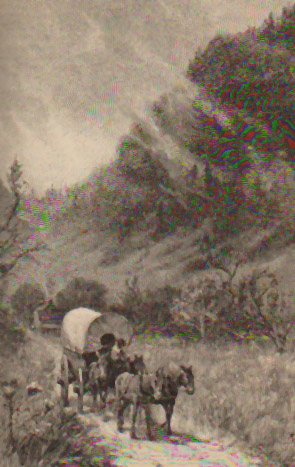
THE TREK TO OHIO AND INDIANA
The year of John Rhode's leaving South Carolina probably was about 1814, as Annie Dash Moorer of South Carolina found evidence of his signing legal documents in South Carolina at that date. Accompanying John Rhode was his wife, Mary, and their three younger sons. Their ages at that time: Caleb 24, Thomas 17, and Seymour 14. As has been stated above, sons William and Jonathan had left South Carolina some time before. Left behind were John Rhode's daughters, Ester and Mary, who had married. Whether any neighbors were in the caravan is not known.
The route followed by John Rhode was probably the main route the Virginians and South Carolinians followed, which passed from the Valley of the Shenandoah through the mountains into Kentucky, whence they and the Kentuckians reached southwestern Ohio.
No doubt a number of wagons were taken, drawn by oxen. According to Fannie (Rhode) Cobb, a descendant of William Rhode, as told to a distant cousin Fern Williams and a niece Ruth (Rhode) Fisher, the following stops were made on the trip that finally ended in Warren County, western Indiana, in 1826:
First—They settled in the "Western Reserve," a strip of land in northern Ohio bordering Lake Erie. The "Western Reserve" had formerly belonged to the State of Connecticut, but was taken over by Ohio when she was admitted as a state in 18O3.
Second—They moved to Seymour in southern Indiana.
Third—They moved to Warren County in southern Ohio.
Fourth—They moved to Wayne County near Richmond in eastern Indiana, where Indiana census records of 1820 are said to show they were residents.
Fifth—They moved to Warren County, Indiana, near the town of Attica, on the banks of the Wabash River in the western part of the state. Here on 13 September 1826 John Rhode entered 357 acres of land, where he made his permanent residence. (Research conducted by Dr. Robert T. Rhode and Ann Miller Carr has revealed that the family legend that Ellis Rhode related is not factual. Annie Dash Moorer, a Murray family researcher from St. George, Dorchester Co., South Carolina, may have found records in the 1930s that indicate John Rhode signed legal documents in 1814 in South Carolina; there was at least one more John Rhode/Rhodes/Rode/Roads in the St. George area at that time. There are Rhode and Cobb family members in Iowa that say their family stories have John Rhode and Semer Cobb traveling to St. George around 1814 or 1814 to sell their South Carolina property. This was around the time that John and Mary Lewis Rhode's daughter Mary Rhode, who, along with her sister Esther/Hester, stayed in South Carolina with relatives and never moved to Ohio, married William Murray. John Rhode may have filed a quit claim deed on his property to his daughter Esther, who is unmarried and a landowner in 1825, according to the tax rolls in Colleton Co. Unfortunately, the Colleton Co. courthouse burned during the Civil War, destroying the deeds. Accordingly, there is no way of knowing when John Rhode and Semer Cobb sold their South Carolina land. Because of Annie Dash Moorer's evidence, Ellis maintained that William Rhode was the first to leave South Carolina, followed soon afterward by Jonathan Rhode, but Quaker records, deeds, and other court documents in Warren Co., Ohio, confirm that John and Mary Lewis Rhode were the first to leave St. George. John and Mary and sons Jonathan, Caleb, Thomas, and Seymour Cobb Rhode were in Warren Co., Ohio, by 1806. Ellis was also confused about their migration first to the "Western Reserve," or Connecticut Fire Lands in northern Ohio. Well-known pioneer John Cleves Symmes had large tracts of land there, but what Ellis did not know was that Symmes also had smaller tracts in Warren Co., Ohio. This was the Symmes land purchased by John Rhode. No evidence has been found that John and Mary Rhode ever lived in the Western Reserve. It is quite doubtful that they would have considered a move there, as there was no Quaker MM in that region. John and Mary Lewis Rhode, along with other Quakers, removed to the Miami MM in Waynesville, Warren Co., Ohio. As time went on, there were many Quakers and a number of Quaker MM houses in Warren Co. and adjacent Clinton Co., Ohio. Also, there is no evidence that John and Mary Lewis Rhode ever lived in Seymour, Jackson Co., Indiana. They were devout Quakers, and there was no Quaker MM in that area. The closest one was in Morgan Co., Indiana. There is evidence that Semer and Esther Lewis Cobb moved there in 1813. The part of Jackson Co. where they lived was split off in 1816 to form Lawrence Co., where Semer and Esther lived for about five years. John and Mary Lewis Rhode owned land in Warren Co., Ohio, and across the county line in Clinton Co., Ohio, near where Semer Cobb and Caleb Easterling lived. Their land parcels were all near the site of the Caesar's Creek meeting. As their sons matured and married, Jonathan (until he joined William in Wayne Co., Indiana), Caleb, Thomas, and Seymour Cobb Rhode may have lived on several of the land parcels owned by their parents. John and Mary may have moved briefly to Wayne Co., Indiana, where they are found in the 1820 census, or, perhaps, they were visiting sons William and Jonathan at the time the census was taken. William and Sarah Murray Rhode settled in Wayne Co., another area with a large Quaker population, when they moved from South Carolina in 1812. Jonathan also moved there at some time after his marriage in 1813. Even if they did live in Wayne Co., Indiana, briefly, John and Mary may have moved back to Warren Co., Ohio, after a short while. John Rhode never bought land in Wayne Co., Indiana, and he did not sell his land in Warren and Clinton Counties, Ohio, until 1827, after the Rhode clan moved to Warren Co., Indiana.)
INDIANA THE PROMISED LAND
After so many stops in various places in Ohio and Indiana, the country along the banks of the Wabash River in Warren County, western Indiana, evidently was the promised land for John and his wife, Mary, along with their sons, some with families, as the Rhode family had increased in size in the years since they had left South Carolina. The slaves they had taken with them from South Carolina had been freed in Ohio. The old black trunk was opened up again, and successive land entries were made by various members of the family. All five sons, William, Jonathan, Caleb, Thomas and Seymour, engaged in farming in this area. Later Caleb, Thomas and Seymour moved west.
So in 1826 was started the second settlement of the Rhode family in America. This settlement in the years to come was destined to become the largest settlement that the descendants of John and Mary Rhode were to make.

CARVED OUT OF THE WHITE OAK FORESTS OF INDIANA
John Rhode was like the old Indiana Hoosier who said: "Now, Josh, you get a plenty while you're gettin' sez I"—so John Rhode and his sons entered large tracts of land and proceeded to chop and grub farms out of the primitive white oak forest. There was very little prairie land as most of the land was heavily timbered. It has been said that this was the finest stand of hardwood timber that the world has ever produced.
A small part of this timber was used for buildings and rail fence, but the greater part was chopped down, the logs rolled together and burned. The stumps had to be grubbed out before the land was ready for the plow. Some of the stumps that were left at first were to be grubbed out from time to time in later years. Unless one has actually cleared land himself he has little idea of the backbreaking job it is to get timber land ready for the plow. In those days it was no wonder the Hoosier was famed for his ability with the ax.
In the early days 1820 to 1840, the Wabash, White and Ohio rivers were the highways of commerce, and nine-tenths of the surplus produce was shipped down these streams by flatboat to the Mississippi River and to New Orleans.
DESCRIPTION OF PIONEER DAYS IN INDIANA*
"No one could guess from the aspect of Indiana today that when the first settlers entered it the greater portion was covered with dense growths of magnificent hardwood trees—oak, walnut, beech, ash, maple and the king of the Wabash valley, the giant sycamore—in all more than 110 kinds of trees, which not infrequently reached a height of 100 to 190 feet and a circumference of 25 to 35 feet. It makes one shudder to realize that most of these huge and splendid forest monarchs did not even furnish timber or fuel, or serve any useful purpose. They were simply cut, piled in heaps, and burned with immense labor to clear the land for planting. It could not be helped. The forest was a barrier to progress, a foe to agriculture, and a refuge for Indians, bears, panthers, wildcats, and lynxes, as well as for deer and other gentler wild creatures.
"The stout Hoosier pioneers, snatching at every opportunity to sweeten toil and hardship with fun and frolic, made the 'log-rolling' a community festival. The 20 to 50 men of a neighborhood would gather early in the day with axes and handspikes at the home of one of their number, and, divided into opposing squads, would make a game of seeing which side could outdo the other in heaping the logs for burning. In the log cabin their women folk were busy quilting and preparing the feast of venison, roast turkey, fried chicken, hog, hominy, potatoes, hot cornbread, biscuit, and gingerbread, pies, preserves, milk and cider. In the evening the young people would still have energy left for dancing and games, while a hundred flaring log bonfires lit the sky. Each settler received the same help from his neighbors, so the festivity was repeated many times during the season, usually April or May.
"The log-rolling was a splendid opportunity for political candidates to ingratiate themselves with the voters; an opportunity, too, for the canny farmer, who, it is said, would sometimes postpone his log-rolling until campaign time in order to profit by the enthusiastic labor of rival candidates. ('Log-rolling' by the way, still remains in our political vocabulary as a term for barter of political favors and services."
*Quoted from Compton's Encyclopedia, 1932 ed., vol. 7, p. 47.
SEYMOUR T. RHODE'S IMPRESSIONS OF INDIANA IN 1870 AND 1910*
"In 1870 when I visited Indiana, there were a few odd tracts of this very magnificent timber left standing. Uncle Seym had about twenty acres that there never had been an ax in; mammoth oaks many of them sixty feet or more to the nearest limb and with a superb spread of tops. As a young man from the prairie country of Iowa, it surely was impressive and had a very lasting effect. Forty years later, in 1910, while visiting with the Grey family at Odessa, Indiana, my Cousin Harvey Garton drove me to an eighty-acre tract that had been preserved. In fact this eighty acres stood like a mountain in a valley. The timber was mostly oak and yellow poplar. The effect is lasting to this day. But alas, time was called on the preserver, and the heirs were calling for their share. Harvey Garton said the tract had been sold for $1000 per acre or $80,000 for the timber alone. I thought of the back breaking work those old timers had done in getting rid of their timber: chopping down the trees, piling the logs, then burning, and to think of the stumps to wrestle with after the logs and limbs were off."
*Quoted from a letter written in 1934 by Seymour T. Rhode (Joseph Jonathan John) of Randolph, Iowa, to his nephew, Ellis G. Rhode.
(Today there are few of the original trees left standing in this part of the state; it looks as though it had always been a prairie country.)
DRAINING THE LAND
After the land in western Indiana was cleared, it was found that it was not well drained; there was much sickness, and chills and fever were the regular thing. Because of the wetness of the land, it was almost impossible to raise crops, so the land had to be ditched and tiled. The first tiling was three-inch, then the land was retiled with four-inch tiling, which was later dug up, and six-inch to eighteen-inch tile was put in which gave good drainage.
THE JOHN RHODE HOUSE
Seymour T. Rhode of Randolph, Iowa, in his letter written in l934, continues:
"On this trip to visit the Rhode relatives in Indiana in 1910, I visited John Rhode's old residence. It was built of brick. It stood in a field, and at that time, after almost four score of years, was in an excellent state of preservation. I splintered some wood off the window frames, but I suppose they are long since lost in the shuffle."
(In 1958, after around 130 years, part of this old house still stands, but it has not been occupied for many years.) [Don Babcock provided the following photograph of John Rhode's house. He writes, "This photo was taken about 1962. The house was demolished in the later 1960s because of new taxation laws. The Rhode family made their own bricks, and Elsie Jane Smith gave me one from this house that she rescued while the bulldozer was working." To the best of Dr. Rhode's knowledge, no trace of the house exists today. A woods covers the area.]
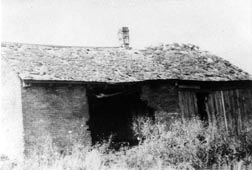
LAND STILL FARMED BY DESCENDANTS OF JOHN RHODE
The land selected by John Rhode and his sons in western Indiana is still in the hands of their descendants. [Dr. Rhode notes that the previous statement is not as true today as it was when Ellis G. Rhode composed this history.] Not only have the descendants held the original tracts of land, but they have bought adjoining land, so that much of the land around Pine Village and Attica is owned and farmed by Rhode descendants.
The following is a quotation from the Fountain-Warren Democrat published at Attica, Indiana, under the date of 16 January l940:
"Not only is the Rhode family numbered among the first families of Warren County, coming here from the Carolinas, but today it is among the leading families of the county, with a record of more than a century spent in the development and upbuilding of the county."
SONS AND DAUGHTERS OF JOHN AND MARY RHODE
William (1785-1858) married Sarah Murray. Thirteen children. Farmers. Warren County, Indiana
Jonathan (1788-1845) married Mary Anderson. Eight children. Farmers. Warren County, Indiana
Caleb (1790- ) married Rachel Little. Four children. Lived in Kansas.
Ester (1794- ) married ____________ Summers. [Dr. Rhode notes that Ester Rhode's name is spelled Esther Rhode on the tombstone erected in Quaker Cemetery in 1997 by Rhode descendants. See photograph below.] Four children. Lived in South Carolina.
Mary (1796-1836) married William Murray, Jr. Three children. Farmed plantation in South Carolina.
Thomas (1797-1858) married Mary Ballard. Twelve children. Farmers. Salem, southeast Iowa.
Seymour (1802-1861) married Rebecca Hurley. Six children. Farmers. Warren Co., Indiana; moved to Iowa in 1855.
[ANN MILLER CARR'S EXCITING RESEARCH, CONTINUED]
In 2002, Ann wrote the following: As for Esther Rhode Summers, I found her family in the 1850 Colleton County census. Only one of her children, her only daughter, Elizabeth Summers Appleby, survived after 1864. I found an 1864 probate for George Summers, son of Daniel and Esther Rhode Summers, in Colleton County. It was one of the earliest they had, as the courthouse was burned during the Civil War. In the file is a letter from Richard Hiram Appleby (Ellis and the diary have him as Hiram.) that states he is the rightful heir to George's property because of his marriage to George's sister, who is the only surviving sibling. Richard Hiram, who signed his letters "R.H. Appleby," sent a follow-up letter appealing the decision (which obviously went against him), saying he was destitute and had little children. I found him and Elizabeth in the 1870 census; they had a son, John, age one, and a daughter, Mary, age four. What happened to Daniel and Esther's other sons, John and William, is unknown, as is the cause of George's death. Did all three die fighting for the Confederacy? I know the Lewises and the Rhodes were Quakers, but maybe Esther did not follow that faith after her marriage. Also, it seems that the family story about Esther Rhode being married when her family left for Ohio may be erroneous. There are indications that Esther did not marry until the mid- to late 1820s. Her first child in the census, John, was born in 1831. Perhaps she and Daniel had other children who were out of their home by 1850. In any case, none survive but Elizabeth. According to a 1954 letter in the Appleby family file in the Charleston, South Carolina Historical Society Library, a grandson of one of Richard Hiram Appleby's brothers (therefore Richard Hiram's grand-nephew) says that his "father had a brother, Hiram, who moved to Goliad County, Texas and that some of Hiram's descendants now live in San Antonio." Here is information on Daniel Summers:
Descendants of Daniel Summers
Generation No. 1
1. DANIEL1 SUMMERS was born 1790 in South Carolina, and died Bet. 1850 - 1860 in Dorchester Co., South Carolina. He married ESTHER RHODE in Colleton Co., South Carolina, daughter of JOHN RHODE and MARY LEWIS. She was born March 17, 1794 in Dorchester Co., South Carolina, and died March 29, 1861 in Dorchester Co., South Carolina.
Notes for DANIEL SUMMERS:
Daniel Summers is enumerated as Dan'l Somers in the 1850 census, St. George's Parish, Colleton Co., South Carolina, pg. 241B/481 or 14 of 46 on Ancestry.com. In the household are Daniel, Esther, and sons John, William and George and daughter Elizabeth. The census taker seems to have Daniel and Esther's ages switched, as he says Daniel is 56 and Esther 60.
More About DANIEL SUMMERS:
Residence: Dorchester Co., South Carolina
Notes for ESTHER RHODE:
Esther Rhode, the elder daughter and fourth child of John and Mary Lewis Rhode, was born on March 17, 1794 on her parent's plantation on the Edisto River in Dorchester Co., South Carolina, near the small town of St. George. She married Daniel Summers; the date of the marriage is uncertain. Also, it is not known whether she was married in 1811, when her oldest brother, William, left for the Western Reserve in northern Ohio near Lake Erie. Her brother Jonathan also left, either with William or shortly afterwards. The Rhodes were Quakers, and many Quakers, like her brothers, left the South after 1800 because they decided slavery was wrong.
Although Rhode family historians say that Esther Rhode Summers was married (and perhaps a mother) by the time her parents, John and Mary Lewis Rhode, and her other brothers, Caleb, Thomas and Seymour left South Carolina for the Western Reserve in 1814, it is possible that Esther stayed in South Carolina with her sister, Mary.
John and Mary Lewis Rhode's daughter and Esther Rhode Summers' sister, Mary Rhode Murray, had just married in 1813. She and her husband William Murray, and her husband's four children from his previous marriage, also stayed in South Carolina on their own plantation in Dorchester Co.
Esther Rhode Summers and her husband had at least four children, John, William, George and Elizabeth. George died in November of 1864. In 1866, Elizabeth's husband, Richard Hiram Appleby, petitions the probate court regarding George's estate, saying that he is the only living heir by marriage to George's sister. So, in any case, by 1866, all of Daniel and Esther's children were deceased with no issue except Elizabeth.
Children of DANIEL SUMMERS and ESTHER RHODE are:
i. JOHN2 SUMMERS, b. 1831, St. George's Parish, Dorchester Co., South Carolina; d. Bef. 1864.
ii. WILLIAM SUMMERS, b. 1833, St. George's Parish, Colleton Co., South Carolina; d. Bef. 1864.
iii. GEORGE SUMMERS, b. 1838, South Carolina; d. November 20, 1864, Colleton Co., South Carolina.
Notes for GEORGE SUMMERS:
George Summers was unmarried and childless at the time of his death.
2. iv. ELIZABETH SUMMERS, b. 1843, St. George's Parish, Dorchester Co., South Carolina; d. Bef. 1920, Goliad Co., Texas(?).
Generation No. 2
2. ELIZABETH2 SUMMERS (DANIEL1) was born 1843 in St. George's Parish, Dorchester Co., South Carolina, and died Bef. 1920 in Goliad Co., Texas?. She married RICHARD HIRAM APPLEBY January 30, 1861 in Dorchester Co., South Carolina. He was born 1840 in St. George's Parish, Dorchester Co., South Carolina, and died Bef. 1920 in Goliad Co., Texas?.
Notes for ELIZABETH SUMMERS:
From the diary of David Gavin, a Dorchester Co. resident in the mid-1800s, who kept a diary of his family and friends from 1855-1874, which is now in the archives at the University of North Carolina at Chapel Hill:
"Hyram Appleby son of Jas. P. Appleby and Miss Summers daughter of Hessee & Daniel Summers were married January the 30th 1861. Hyram Appleby married Miss Felder daughter of F. I. Felder first who died since the 22d of Nov. 1860. It is said he married his 2d wife about six weeks after the death of his first. It was 50 days."
Notes for RICHARD HIRAM APPLEBY:
Richard Hiram (R.H.) Appleby petitions the Colleton Co. probate court in 1866 to be declared administrator of his late brother-in-law George Summers' estate, saying that he is the only heir to the estate "by marriage to his sister."
In a later paper in the estate file, he petitions that other parties (lawyers) are holding up his rightful inhertance. He says "under his present circumstances" that this is intolerable, and that he has little children who are suffering. His letter leads one to assume that his property was confiscated after the Civil War and that his family is destitute.
According to papers in the Charleston Co., South Carolina Historical Society, Richard Hiram Appleby's nephew, Alfred, a son of his brother Franklin Appleby of Fruitland, Florida, states that "my father's brother Hiram moved to Goliad (Co.)Texas and his descendants live in San Antonio."
More About RICHARD HIRAM APPLEBY:
Residence: 1879, St. Georges Parish, Colleton (now Dorchester) Co., South Carolina
Children of ELIZABETH SUMMERS and RICHARD APPLEBY are:
i. MARY3 APPLEBY, b. 1866.
ii. JOHN APPLEBY, b. 1869.
Ann Miller Carr took the following photographs in 2002:
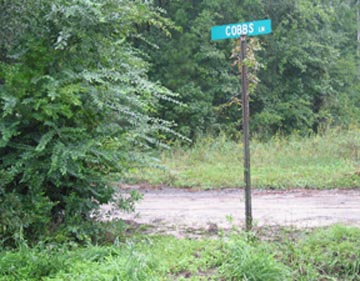 | 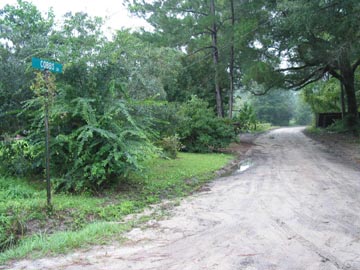 |
Once Semer Cobb's Land, Dorchester Co., South Carolina | Cobb's Lane, Dorchester Co., South Carolina |
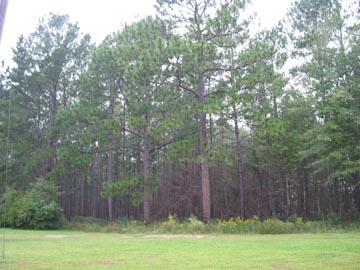 | 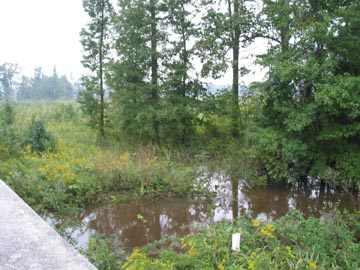 |
What Was Once John Rhode's Arable Land in South Carolina | Gum Branch of Edisto River on Former Rhode Land |
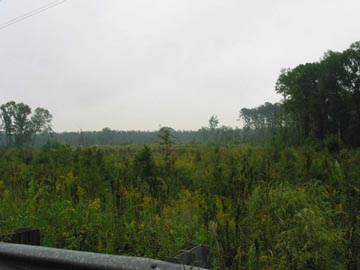 | 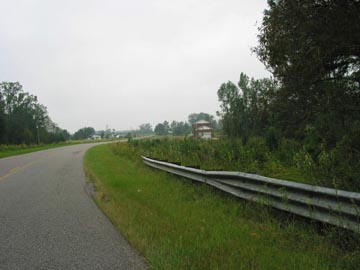 |
Once John Rhode's Land in South Carolina | Main Road Through What Was Once Rhode Land |
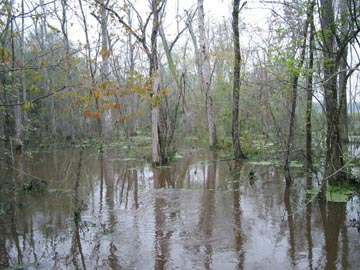 | 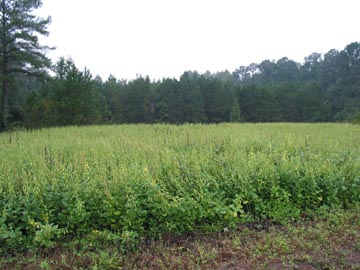 |
Swamp on What Was Once John Rhode's Acreage | Once Semer Cobb's Land, Next Door to John Rhode's Place |
Ann Miller Carr took the following photographs in 2004:
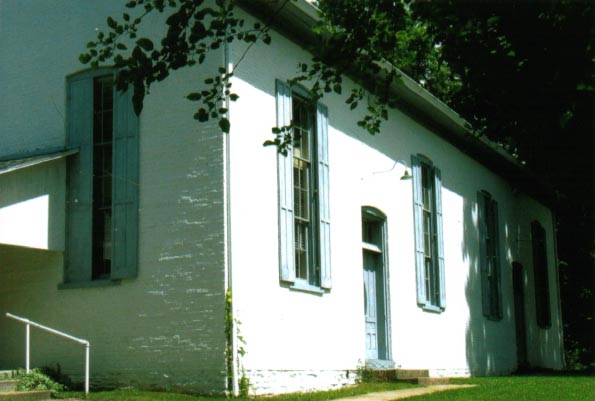 | 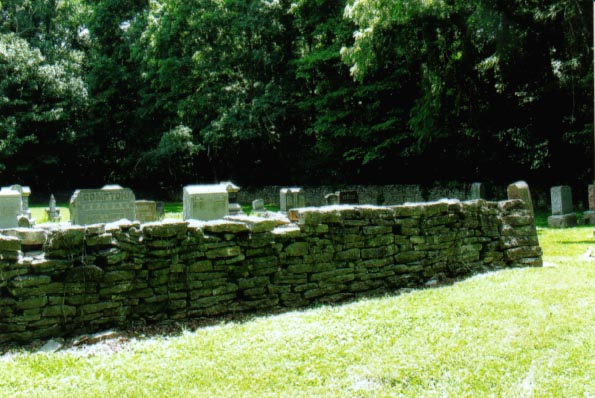 | |
Friends Meeting in Waynesville, Ohio, Attended by Rhodes | Cesar's (Original Spelling) Creek Cemetery Near Rhode Land | |
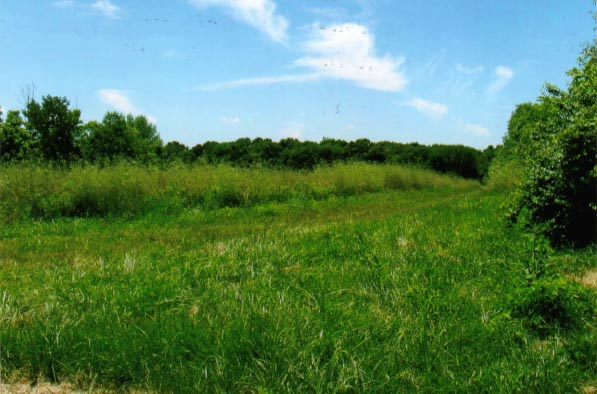 | 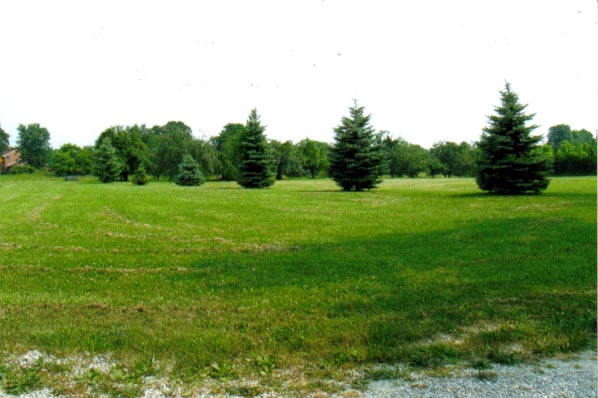 | |
View South from Cemetery Toward Rhode Land in Warren Co. | Semer Cobb Land in Clinton Co. Adjacent to Rhode Land |
[At this point, we return to Ellis G. Rhode's manuscript.]
LAST RESTING PLACE OF JOHN AND MARY (LEWIS) RHODE
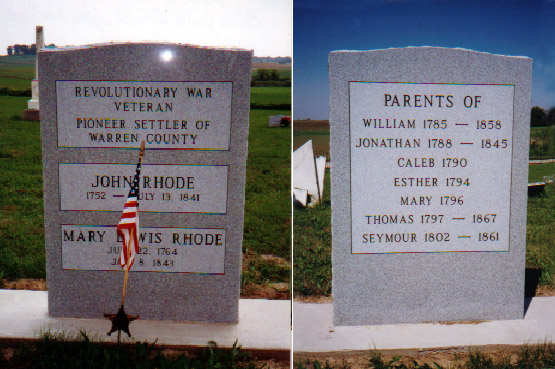
John Rhode passed away on 13 July 1840 at the age of 88 years. Mary Rhode, his wife, died on 8 January 1843 at the age of 78, living 2½ years after the passing of her husband. They are buried in the Quaker Rhode family graveyard, located on the old John Rhode homestead, between Pine Village and Attica, Indiana. Many of their descendants have since been buried in this family cemetery.
As a young man, John Rhode had left his home and friends and the familiar scenes of his homeland and had crossed the wide ocean to the strange new land of America, where In the early pioneer days of America he was to take an important part in building a new country destined to become great and strong in the years to come.
John Rhode and his wife Mary lived long and eventful lives during these early pioneer days of America, starting with Revolutionary War times, taking part in the historic migration from the Atlantic seaboard to mid-west America, where with their sturdy sons they founded the second Rhode settlement in America.
They lived to see their sons raise families of their own and prosper in upbuilding and developing together the agricultural resources of this largest Rhode settlement, which has been continued by their descendants.
JOHN RHODE AND MARY (LEWIS) RHODE—early American pioneers.
FOUNDERS OF THE RHODE FAMILY IN AMERICA.
[The following excerpts are from Alfred B. Rhode's article entitled "Shiloh: South Carolina, Mississippi, Texas," which appeared in the Palatine Immigrant, Vol. 6, No. 1, for the summer of 1980.]
The small wooden frame Methodist Church at Shiloh, Texas, located about 7 miles north of Hallettsville in Lavaca County, now being used as a community center and sentinel over the adjoining cemetery, has a most interesting heritage. This Shiloh story reaches back over two centuries and starts with German and Swiss immigrants who originally settled in and around Orangeburg, South Carolina.
During the years 1735-40, several boatloads of "Palatine" families landed in the Charleston SC area. Some of these families moved further inland, settling between Four Holes Swamp and the Edisto River, in Orangeburg Township. They were given land grants of 50 acres each and provisions to last for one year.
Records tell us that included among these families were such names as Roth, Traxler, Kersh, Rucker, Myers, and Oesterling. Since these families neither spoke nor wrote English and the rules of the province were in English, some of the names were written the way the British tax collectors and other officials thought they sounded when spoken. As a result, Roth reportedly was changed in time to Rode, Road, Rod, Rote, Rhoad, Rhode(s) and perhaps others.
. . . . .
In the early 1820's, a migration of some of these families took place. They moved out of their SC homesteads in search of greater opportunities and more freedom. They apparently left in family groups, heading westward.
One such group, seeking their fortune in the bonanza land of Texas, followed a route through Mississippi. It was a long and tortuous trip by ox-drawn covered wagon, requiring extended rest stops along the way. While they camped near a spring of clear fresh water on a branch of the Pearl River in Rankin County, MS, the women mended and washed, and the men hunted and repaired their wagons and harness. One of the Rhode children, swinging on a grapevine or branch, fell and was injured so critically that he (or she) later died. They buried the body near their camp site. The family was so bereaved they elected to remain there to be near the grave, rather than to continue the journey.
Other families joined them, and a decision was made to build a church. The church, built about 1828, was named Shiloh Methodist. There is some reason to believe the name was selected for their church because the church they left behind in South Carolina had also been named Shiloh. . . .
. . . . .
About 1855, some of the younger generations of these families continued their delayed journey to Texas. They went in a caravan of about 20 wagons: Rhodes, Chapman, Hoffman, Kersh, Rucker, Brown, McBride, Easterling, Griffith families and others. When the group reached Texas, they first considered Karnes County, but few remained there. The majority continued their march until they reached a place midway between the towns of Hallettsville and Shulenburg, along the Navidad River. . . .
. . . . .
I have located a Rhode "relative" living in Holly Hill, South Carolina, who says the Rhode family came to America in 1730-35 and that his great great grandfather was Joseph Linder Rhoad who married Sarah Metts, also a German. He says he has proof Joseph Linder's father was John Rhoad (1768-1830) and a Methodist minister in the Branchville, SC area.